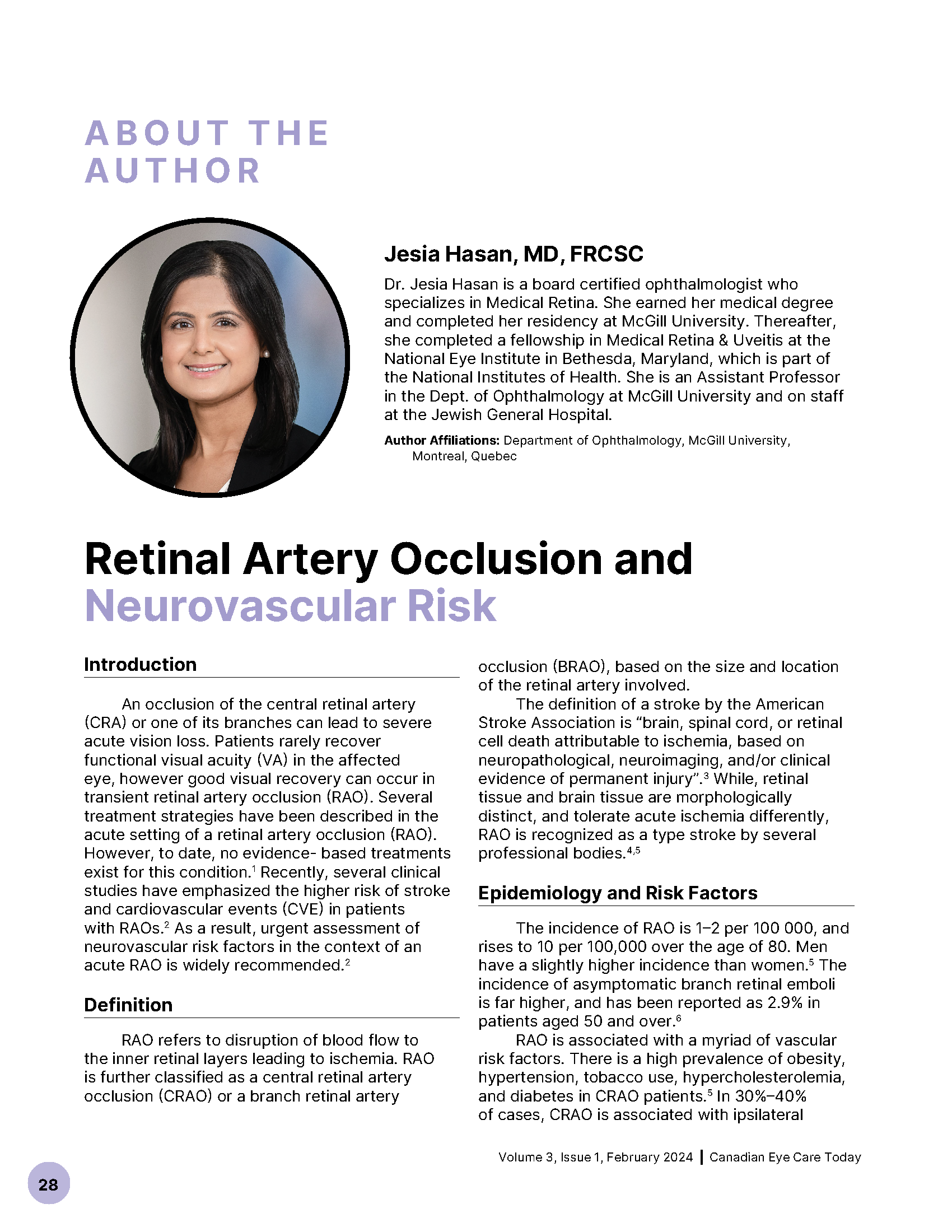Retinal Artery Occlusion and Neurovascular Risk
Abstract
An occlusion of the central retinal artery (CRA) or one of its branches can lead to severe acute vision loss. Patients rarely recover functional visual acuity (VA) in the affected eye, however good visual recovery can occur in transient retinal artery occlusion (RAO). Several treatment strategies have been described in the acute setting of a retinal artery occlusion (RAO). However, to date, no evidence- based treatments exist for this condition. Recently, several clinical studies have emphasized the higher risk of stroke and cardiovascular events (CVE) in patients with RAOs. As a result, urgent assessment of neurovascular risk factors in the context of an acute RAO is widely recommended.
References
Lin JC, Song S, Ng SM et al. Interventions for acute non-arteritic central retinal artery occlusion. Cochrane Database of Syst Rev. 2023;1(1):CD001989.
Scott IU, Campochiaro PA, Newman NJ et al. Retinal vascular occlusions. The Lancet. 2020; 396(10266):1927–1940.
Sacco RL, Kasner SE, Broderick JP et al. An updated definition of stroke for the 21st century: a statement for healthcare professionals from the American Heart Association/American Stroke Association. Stroke. 2013; 44(7):2064–2089.
Hayreh SS. Is management of central retinal artery occlusion the next frontier in cerebrovascular diseases? Journal of Stroke and Cerebrovascular Diseases. 2019;28(2):256-258.
Mac Grory B, Schrag M, Biousse V et al. Management of central retinal artery occlusion: A Scientific Statement from the American Heart Association. Stroke. 2021; 52(6):282-294.
Cugati S, Wang JJ, Rochtchina E et al. Ten-year incidence of retinal emboli in an older population. Stroke. 2006; 37:908–910.
Chodnicki KD, Tanke LB, Pulido JS et al. Stroke risk before and after central retinal artery occlusion: A population-based analysis. Ophthalmology. 2022;129(2):203–208.
Chen JJ, Leavitt JA, Fang C et al. Evaluating the incidence of arteritic ischemic optic neuropathy and other causes of vision loss from giant cell arteritis. Ophthalmology. 2016;123:1999-2003.
laxel CJ, Adelman RA, Bailey ST et al. Retinal and ophthalmic artery occlusions preferred practice pattern®. Ophthalmology. 2020;127(2):259–287.
Schultheiss M, Spitzer MS, Hattenbach LO, Poli S. Update intravenöse Lysetherapie : Die REVISION-Studie [Update on intravenous lysis treatment : The REVISION trial]. Ophthalmologe. 2021 Nov;118(11):1107-1112.
TENecteplase in Central Retinal Artery Occlusion Study. ClinicalTrials.gov identifier: NCT04526951. Updated January 5, 2023. Accessed Febuary 12, 2024.
Schumacher M, Schmidt D, Jurklies B et al. Central retinal artery occlusion: local intra-arterial fibrinolysis versus conservative treatment, a multicenter randomized trial. Ophthalmology. 2010;117(7):1367-1375.
French DD, Margo CE, Greenberg PB. Ischemic stroke risk in Medicare beneficiaries with central retinal artery occlusion: A retrospective cohort study. Ophthalmol Ther. 2018;7(1):125-131.
Chang YS, Jan RL, Weng SF et al. Retinal artery occlusion and the 3-year risk of stroke in Taiwan: a nationwide population-based study. Am J Ophthalmol. 2012;154(4):645-652.
Park SJ, Choi NK, Yang BR et al. Risk and risk periods for stroke and acute myocardial infarction in patients with central retinal artery occlusion. Ophthalmology. 2015;122(11):2336-2343.
Lavin P, Patrylo M, Hollar M et al. Stroke risk and risk factors in patients With central retinal artery occlusion. Am J Ophthalmol. 2018;196:96-100.

Downloads
Published
How to Cite
Issue
Section
License
Copyright (c) 2024 Canadian Eye Care Today

This work is licensed under a Creative Commons Attribution-NonCommercial-NoDerivatives 4.0 International License.
